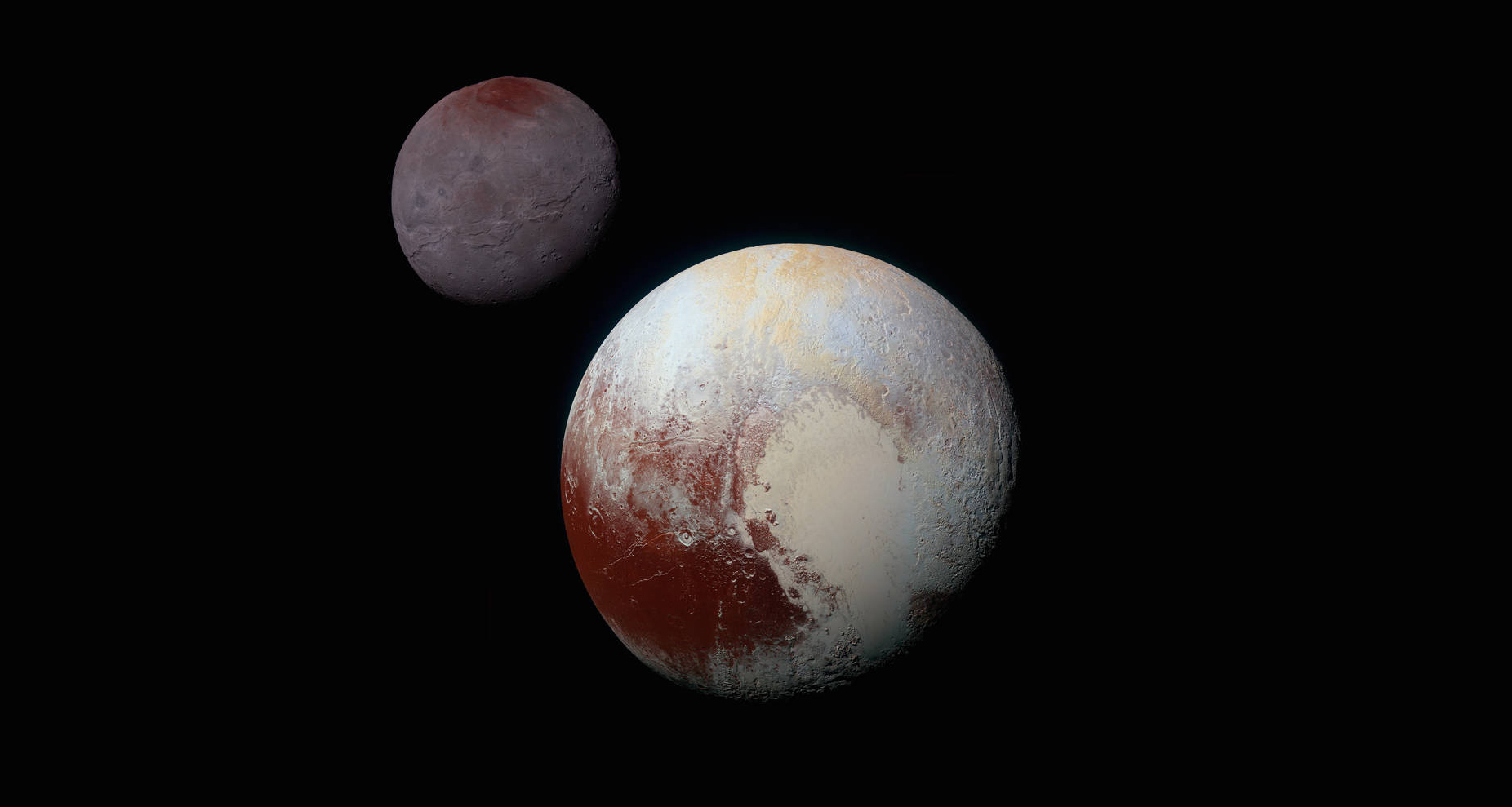
Charon is Pluto’s largest moon and, despite being so cold and remote from the Sun, has been revealed to be a fascinating and active world, just like Pluto itself. Residing in the far outskirts of the Solar System, it had been expected that Charon—and Pluto for that matter—would be little more than frozen, dead worlds. But just like the rest of the Solar System, there were surprises waiting to be found. Thanks to the New Horizons spacecraft, we got our first close-up views of the Pluto system in July 2015. It soon became evident that not only were Pluto and Charon geologically active in the ancient past, but they perhaps still are in some ways even now. One of the most surprising findings was both Pluto and Charon likely had subsurface water oceans; while it is thought that Pluto’s is probably still liquid, Charon’s is likely completely frozen, and now additional evidence for its existence has been published by researchers.
The evidence is presented in a new paper in Icarus titled “Charon Tectonics,” and it suggests that Charon was not only tectonically active in the past, but also possessed a subsurface ocean which is now frozen. The new paper is a summary of observations from New Horizons’ Long-Range Reconnaissance Imager (LORRI, Cheng et al., 2008) and the Multi-spectral Visible Imaging Camera (MVIC) on the Ralph instrument (Reuter et al., 2008). The conclusion in brief is that Charon has undergone “global extension” which produced the tectonic features seen by New Horizons and provides evidence for the subsurface ocean. Basically, expanding ice in the slowly freezing ocean would cause the surface to stretch and fracture. From the paper:
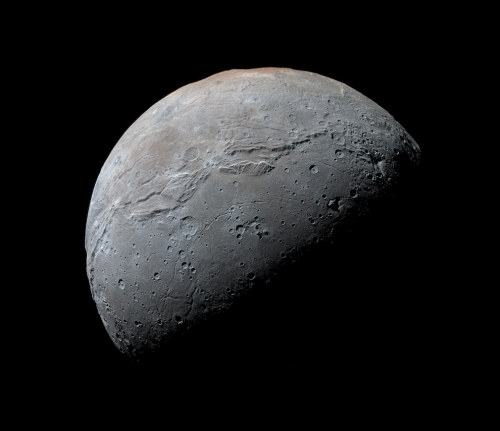
“The global characteristics of Charon’s tectonics are striking: (1) extension dominates over the entirety of Charon’s northern terrain up to and including the scarps that border Vulcan Planum, whose resurfaced units bury the flanks of the rifts; (2) there is no evidence for compressional faulting or strike-slip faulting; (3) the extension is inferred to be relatively ancient (up to ∼4 Ga), based on the superposition of many craters and Vulcan Planum units, which are themselves relatively heavily cratered; and (4) the roughly polygonal extension across the northern terrain does not indicate a preferred direction of extensional stress, whereas the roughly east-west alignment of the major chasmata implies major north-south extension across the entire structural belt represented by the chasmata.
“The widespread patterns of extensional tectonics detailed here suggest that Charon experienced a few kilometers of radial expansion. One possible mechanism for driving such expansion is the refreezing of a subsurface ocean. Charon’s silicate interior likely contained enough energy to initially melt part of an overlying ice shell, especially given the evidence for ammonia in Charon’s compositional makeup (Grundy et al., 2016a). As that heat was lost and the mostly-water ocean froze, the inevitable volume expansion from the phase change would have driven expansion of the crust, leading to extensional tectonics and perhaps cryovolcanism. This assumed sequence of events indicates that all of Charon’s tectonic activity would derive from this ocean-freezing period. Once freezing was complete, Charon became a much less dynamic world, and has been tectonically ‘quiet’ for most of the subsequent history of the Solar System.”
Fault-bounded troughs and scarps can be seen in the equatorial to middle latitudes, transitioning over the north polar region into an irregular zone where the fault traces are not as parallel or obvious, but which contains irregular depressions and other large relief variations. The faults seen on Charon’s “encounter hemisphere” during closest approach by New Horizons likely extend around the whole moon. In some place, the valleys can be up to 4 miles (6.5 kilometers) deep.
Even though Pluto and Charon are a binary system as well as being a dwarf planet and moon system, the geological histories of the two bodies appear to be quite different. Charon’s outer shell is composed of frozen water ice and is very rigid. But on Pluto, the diverse kinds of surface ices (CO, N, CH4, etc.) are much softer. The nitrogen ice glaciers seen on Pluto are not possible on Charon, and Pluto’s thin atmosphere causes additional degradation and erosion of features.
Earlier evidence for the frozen ocean on Charon had been reported on by AmericaSpace as well. An even earlier report, before the New Horizons flyby, also predicted evidence for a former liquid ocean on Charon.
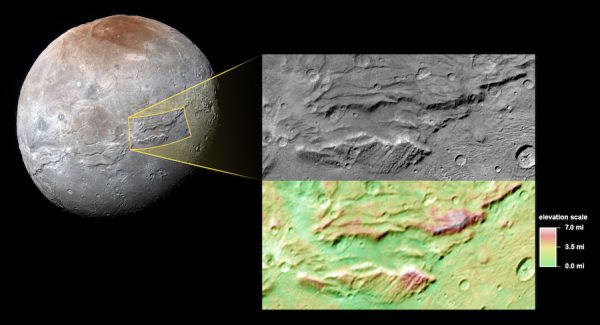
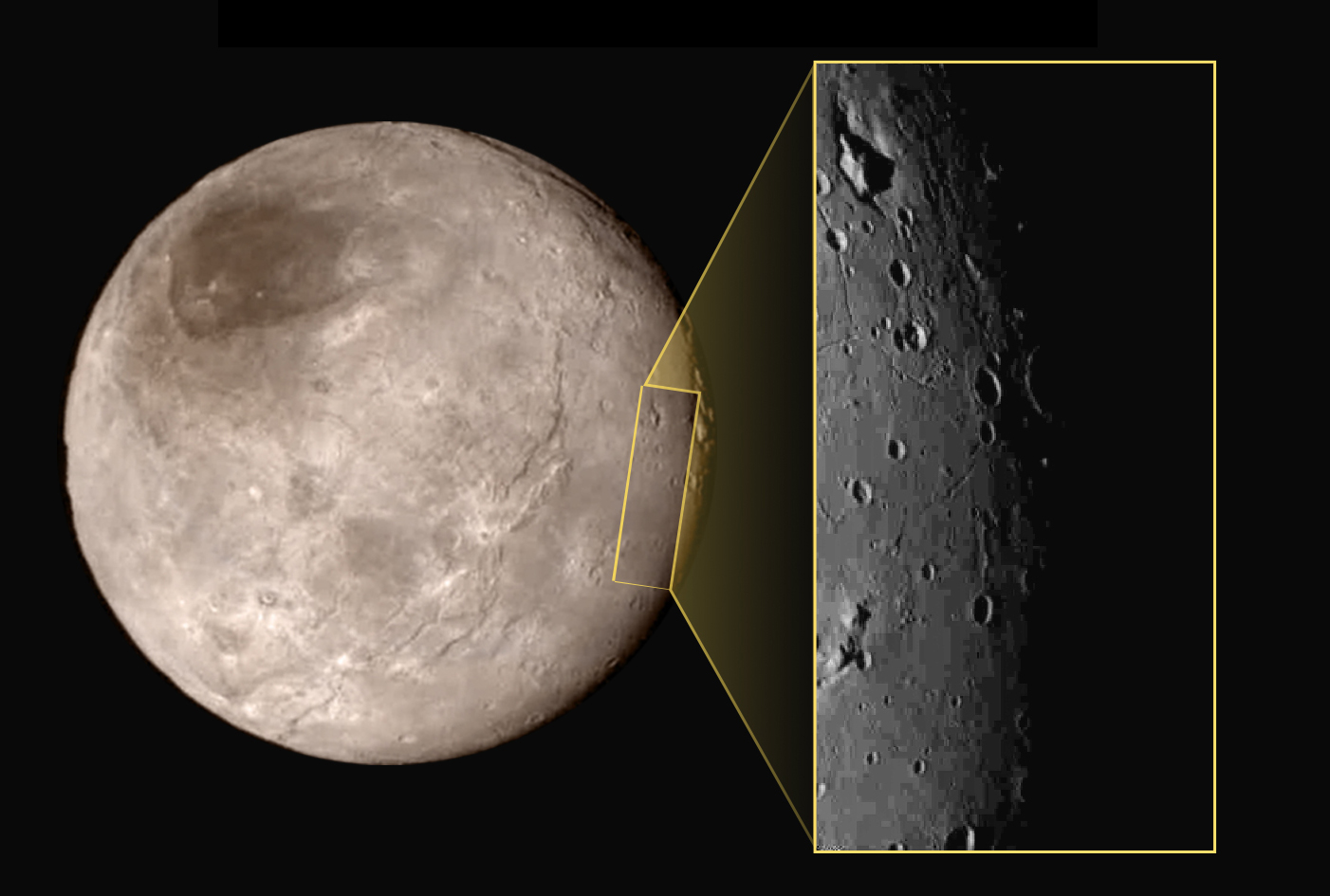
“The New Horizons spacecraft should provide the first images of the surfaces of Pluto and Charon,” according to the researchers, which was published in the journal Icarus. “Our predictions indicate that the presence (or absence) of tidally driven fractures could be used to constrain Charon’s internal structure and orbital parameters at the time of fracture formation. Furthermore, these fractures should be distinct from those produced through orbital recession and de-spinning. If tidally driven fractures are quite prevalent, it would require that Charon experienced a high eccentricity during its orbital evolution and that the ice shell remained relatively warm during this time period. In contrast, very limited tidal fracturing would place upper limits on Charon’s eccentricity and the viscosity of the ice shell. The specific distribution of fractures, either sparse or numerous, could be used to further distinguish between a thick and thin ice shell.”
As also noted by Dr. Alyssa Rhoden, a planetary scientist at NASA’s Goddard Space Flight Center:
“Our model predicts different fracture patterns on the surface of Charon depending on the thickness of its surface ice, the structure of the moon’s interior and how easily it deforms, and how its orbit evolved. By comparing the actual New Horizons observations of Charon to the various predictions, we can see what fits best and discover if Charon could have had a subsurface ocean in its past, driven by high eccentricity.”
Why did Charon’s ocean freeze solid? Radioactive decay of elements as well as some internal heat left over from the moon’s formation would have helped to keep a layer of liquid water beneath the surface, but eventually it would have cooled down with little or no other sources of heat available. Since water expands when it freezes, it kept pushing outward until Charon was almost “bursting at the seams.” This led to fracturing of the surface that dwarfed even the Grand Canyon on Earth. Serenity Chasma, part of a vast equatorial belt of chasms on Charon, is at least 1,100 miles (1,800 kilometers) long, with chasms 4.5 miles (7.5 kilometers) deep. The Grand Canyon is only 277 miles (446 kilometers) long and just over a mile (1.6 kilometers) deep, by comparison. That is incredible geological activity for a body much smaller than Earth.
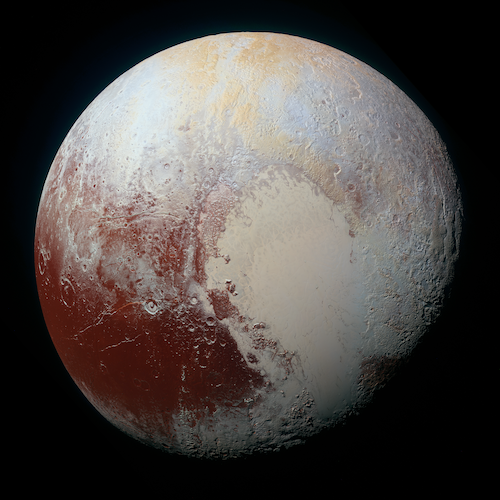
One of the more unusual features on Charon is the “mountain in a moat” where a large mountainous black of material is sitting in the middle of a shallow depression. While not yet how it formed, it is another clue to Charon’s ancient geological history.
“The most intriguing feature is a large mountain sitting in a moat,” said Jeff Moore with NASA’s Ames Research Center in Moffett Field, Calif., who leads New Horizons’ Geology, Geophysics and Imaging team. “This is a feature that has geologists stunned and stumped.”
Charon’s former ocean is fascinating, but it is not unique. As reported previously, Pluto itself is also now thought to have a subsurface ocean, but one that is likely at least partially still liquid. This discovery is even more surprising, since Pluto is far from the Sun in the remote outer Solar System. Similar to Charon, cracks and tension in the surface provide clues to the ocean’s existence, but in Pluto’s case it is not frozen solid.
The findings are part of an update on Pluto discoveries published in UANews and Nature. The focus is on Sputnik Planitia, the large plain of nitrogen ice which makes up half of Pluto’s now-famous “heart” feature. Data from New Horizons shows that Sputnik Planitia appears to be in its present location on the surface due to an accumulation of ice which caused the dwarf planet to “roll over.” This created tension and cracks in the surface which point to a subsurface ocean of water, according to scientists.
To try to determine the interior composition of Pluto, researchers used observations made during New Horizons’ flyby last year and combined them with computer models. This allowed them to take a surface feature such as Sputnik Planitia, shift it around on the planet’s surface, and see what effect if any that had on the planet’s spin axis. Whether Pluto’s ocean could be potentially habitable is unknown at this point, but Alan Stern, principal investigator of the New Horizons mission, thinks it could be, as previously reported by AmericaSpace. It is also thought to likely be similar to subsurface oceans on moons such as Europa, Enceladus, Titan, and others.
“It certainly could be as long as it is warm enough. One other major criteria would be the presence of harmful toxins in the ocean, such as hydrogen peroxide,” Stern said. “The ocean on Pluto could be quite similar to those of icy moons since the same kinds of geological mechanisms are involved, with the same kind of heating process,” he added.
Not long ago, it would have been considered rather crazy to think that Pluto or its moons could have oceans. But now, just like many of the moons of the gas giant planets, it seems they do, or at least did. They are all subsurface oceans, unlike Earth’s, but just the facts that such oceans can exist on many different worlds is a very exciting discovery in planetary exploration.
Follow our New Horizons mission page for regular updates.
Be sure to “LIKE” AmericaSpace on Facebook and follow us on Instagram & Twitter!
Missions » New Horizons »



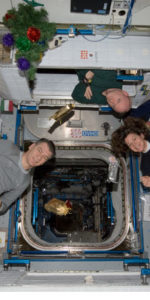
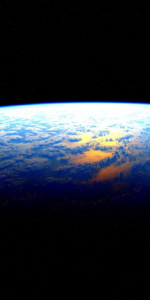
Pluto for Planethood, 2017!!!
MrSottobanco –
I second your motion! Pluto for Planethood, 2017!!!
But I have a few questions.
When will people land on Pluto?
When will we begin to build nuclear pulse Orion spaceships on the Moon?
To paraphrase Shakespeare, “Should we humans boldly travel across all of our Solar System, or should we instead talk a lot about visiting only our Moon and one small Red Planet? That is the question.”
Once we find evidence of life (and we will),it will be interesting to ponder how the evolutionary processes developed in comparison to those on Earth. I believe we have a treasure trove of areas to explore here in our own cosmic “backyard.”